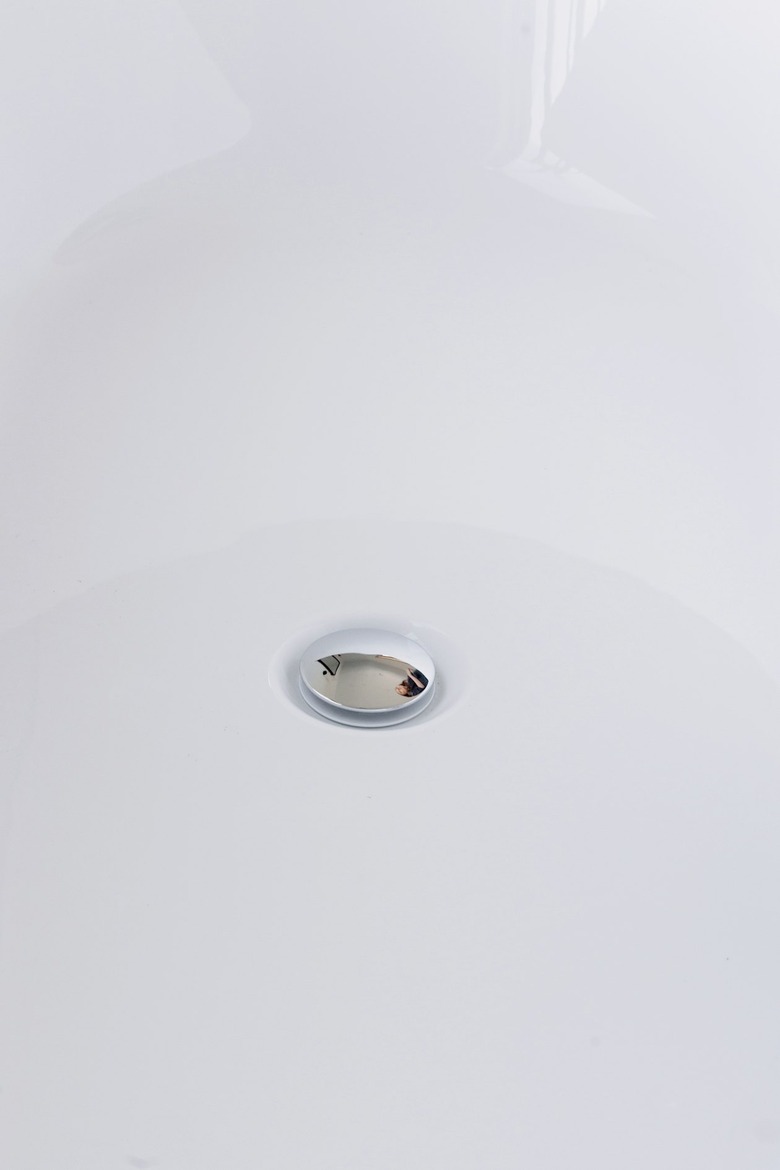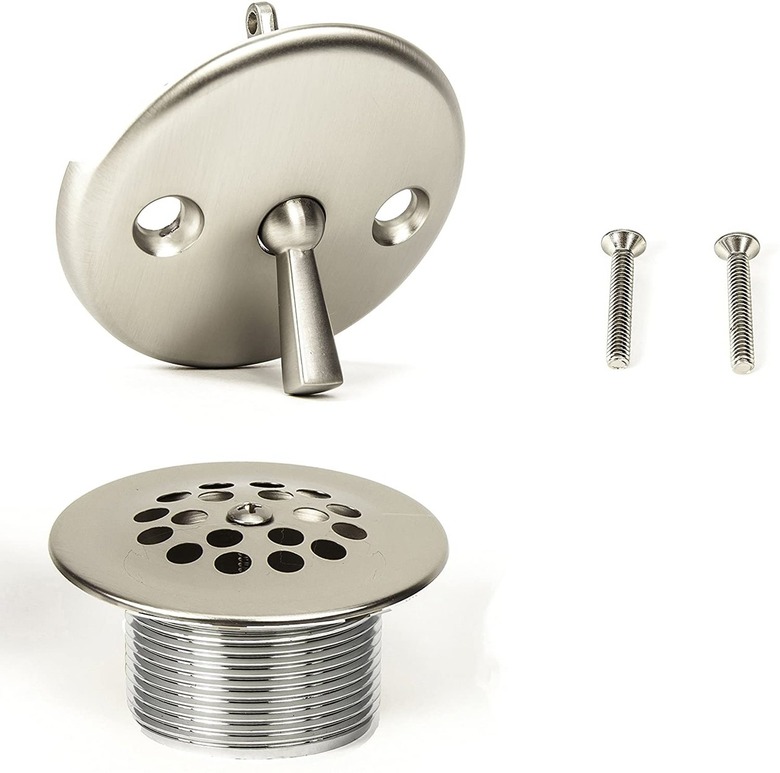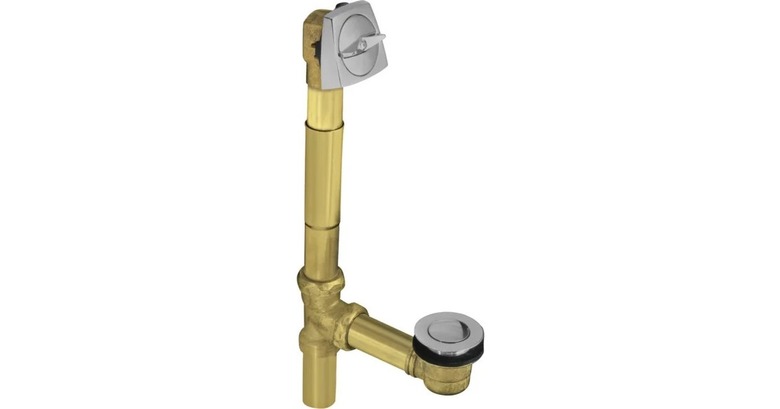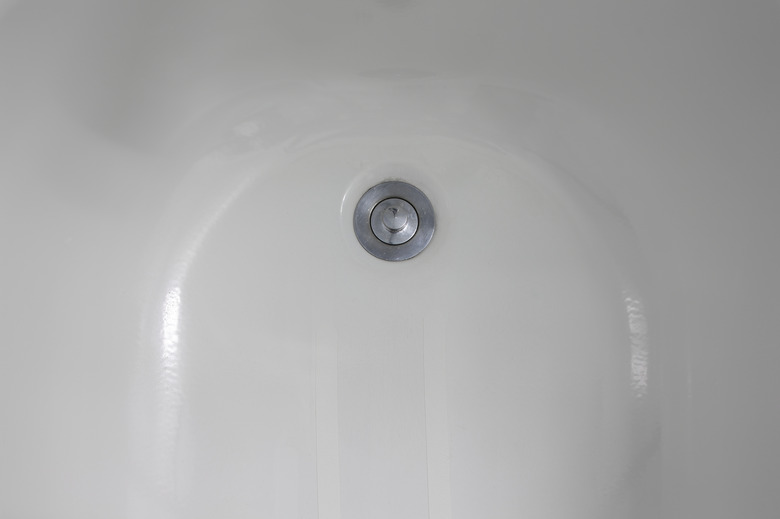How To Fix A Bathtub Drain Stopper
We may receive a commission on purchases made from links.
Soaking in a hot, relaxing bubble bath is the perfect way to wrap up your day — unless that water slowly drains out due to a damaged bathtub drain stopper. Whether it doesn't hold water well or won't move at all, your drain stopper can make bath time a hassle. Knowing what type of stopper you have in your bathtub drain is important since it affects how you disassemble it and repair the issue.
Fixing a Trip Lever With Plunger
Fixing a Trip Lever With Plunger
If your tub has a trip lever, you'll see the lever on the overflow plate, which is on the vertical portion on the front of the tub near the faucet. You can flip it up or down to open or close the drain. The type with a plunger, also called a lift bucket stopper, doesn't have a visible stopper that you can see in the drain. You'll see a plain strainer over the drain.
The part that blocks the water from draining is a plunger, which is usually a weight that moves up and down inside the overflow pipe on the tub. When you flip the lever up to close the drain, the plunger, which is connected to the lever, moves down to block the drainpipe. If the tub fills up too much and goes down the overflow tube, the water can still go through since the plunger is hollow with a hole down the middle. To drain the tub, you flip the lever down to raise the plunger and unblock the drainpipe.
Trip-lever stoppers with plungers are more complex to fix since all of the parts are hidden. You'll need to take off the overflow plate and pull the assembly out that way. You unfortunately can't often troubleshoot or fix any issues without disassembling it.
Troubleshooting the Stopper
Issues with this type of stopper can include a stuck lever, a stopper that doesn't respond, or a plunger that doesn't cover the drain completely. To work on this type of stopper, you need to remove the overflow plate with a screwdriver to unscrew it from the tub. Putting a towel over the tub and drain protects it if the screws drop when you remove them. When you remove the cover, you can pull the assembly with the plunger out through the hole.
Some things to try include:
- Cleaning: Wipe off the plunger if it looks gunky. Buildup could keep it from moving correctly when you raise or lower it. Soaking it in vinegar can help remove the buildup.
- Plunger inspection: Look for corrosion or other damage, which could also keep the plunger from moving smoothly. Replace the assembly if you notice these issues.
- Linkage inspection: Next, inspect the linkage that keeps the plunger connected to the lever. These connections can come loose or can become twisted or tangled, affecting the operation. If the connections are damaged, you might need to replace the entire assembly. If they're twisted or messed up, try straightening them.
- Adjustments: Another potential issue is linkage that's the wrong length. When this happens, the plunger might not drop far enough into the overflow tube to cover the drainpipe completely, which allows water to pass. Turn the adjustment nut clockwise with pliers to make it longer or counterclockwise to make it shorter for a better fit. You might need to test different lengths to get the positioning correct by reinserting the assembly, closing the drain, and filling the tub.
- Broken linkage: Sometimes, the linkage can become disconnected or broken. You might need to fish the plunger out of the overflow tube using a wire with a hook on the end or a similar tool. This typically requires you to replace the assembly.
When you've made your repairs, slide the assembly back through the hole for the overflow plate, reversing the process you used when you disassembled it. Screw the plate back in place. Flip the trip lever up and down to make sure it moves freely. Then, close the tub stopper and run water into the tub to see if it works properly. If not, try additional adjustments or replace it with a new assembly.
Fixing a Trip Lever With Rocker
Fixing a Trip Lever With Rocker
This type of bathtub drain stopper also uses a trip lever on the overflow plate to open and close the drain. The difference is that you can see the stopper in the tub drain, and it moves up and down, which is why it's often called a pop-up stopper. A spring-loaded rocker arm extending through the waste pipe connects the trip lever and the stopper. It opens and closes the stopper when you raise or lower the trip lever.
Troubleshooting the Stopper
The main problem you'll encounter with this type is the stopper not opening correctly, instead staying stuck in the closed position. This can happen if the spring gets clogged with hair and gunk or if the connecting rod isn't adjusted correctly or becomes bent. To remove the stopper, this type requires you to unscrew and remove the overflow cover plate so you can pull the assembly out through the hole. On some models, you need to pull out the stopper along with the rocker arm and spring.
Inspect the spring to see if it has hair, soap scum, or other gunk on it that you can clean. Making the rocker arm longer by adjusting it can also help it work better. You might need to test the adjustment several times to get the length correct.
Once you make the repairs, reinsert it the opposite way you took it out. Replacing the overflow drain gasket while you have the cover plate off is a good idea. Test the drain to see if it works. If it still has issues, try replacing the assembly.
Fixing Stoppers Without a Linkage Assembly
Fixing Stoppers Without a Linkage Assembly
The other broad category of bathtub drain stoppers includes styles that don't have a linkage assembly in the overflow drain. They're attached to the drain itself and are controlled at the stopper rather than with a trip lever. These stoppers sometimes have setscrews to hold them in place. Other times, they can unscrew or pull out of the drain so you can inspect and repair them.
Some types of stoppers in this category include:
- Push-and-pull stoppers: These stoppers work by simply pushing them up and down when you want to open or close the drain. Some similar models are lift-and-turn stoppers where you turn the cap slightly to close it. They can be spring-loaded and also have a rubber seal to stop the water.
- Toe touch: This type of stopper is an easy option that uses a rubber seal to block water. You can operate it with your toe so you don't have to bend over. You can push it down with your toe. Pushing on it again with your toe opens it.
- Flip type: Flip-style drains have a lever on top that you can flip back and forth to open and close the drain. When it's closed, the rubber O-rings press against the drain to seal it closed. To drain the tub, flip it the other way to release the O-rings. The PresFlo is a similar option, but it has a flat piece that you press to flip it open or closed.
Troubleshooting a Push/Pull Stopper
These stoppers typically have a setscrew that you need to remove before you can remove the stopper. There might be a cap that you have to unscrew first to find the setscrew. Sometimes, the issue can simply be that you don't have the setscrew inserted correctly. If it's too tight or too loose, the stopper won't seal properly. Try adjusting the screw first to see if this fixes the issue.
If the screw isn't the issue, remove the setscrew completely and unscrew the stopper to remove it. Remove the stopper from its post. Cleaning gunk from the rubber seal can help, but you might have to pull it off and replace it completely. While you have the stopper removed, clear drain clogs and clean out any hair or other debris down in the drain.
Troubleshooting a Flip-Type Stopper
Flip-style stoppers go in and out of the drain easily with no tools and no screws to hold them in place. To remove the stopper to clean or inspect it, simply flip the lever to release the O-ring and pull it out of the drain. This allows you to clean the rubber seal well and inspect it to look for signs of wear or damage.
If you notice damage or if cleaning doesn't help the stopper seal well, pull the old rubber seal off and replace it with a new one, following the instructions with the replacement seal. They usually go on and off easily. Once you replace the rubber seal, put it back in the drain and flip the switch to close the drain. Run water into the tub to ensure the stopper blocks the drain.
Replacing the entire stopper might be necessary if it still doesn't work properly. Since it doesn't require any tools and screws, it's easy to insert your new stopper by simply putting it into the drain.
Troubleshooting a Toe-Touch Stopper
With a toe-touch stopper, the rubber seal can get sticky due to soap scum and debris, or the rubber seal can wear out completely. To clean or replace it, remove the toe-touch stopper by pulling up the stopper and twisting to remove the cap. If the stopper is sticky, cleaning the rubber seal gently might help. If it looks deformed, torn, or damaged, pry off the rubber seal and get rid of it. Put on a replacement seal.
If the problem is with the shaft, you might need to replace it. There is a screw that holds the shaft in place that you need to remove. Screw the new one in place. Once you make your repairs, screw the cap back into place and test the stopper by closing it and filling up the tub.



